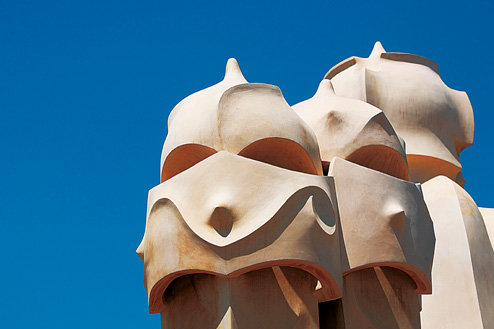Places of Interest
The best places to visit are the former villages. In La Sagrera, this means the market square of Plaça de Masadas, a delightful arched courtyard with cafes in its alcoves. The nearby Plaça de la Assemblea Catalana is a fairly standard residential square most interesting for its name, which honours the aborted attempt at holding the first ever meeting of the Catalan assembly, in 1971. Nearby is Parc Pegaso (93 413 24 00, www.bcn.es/parcsijardins), a pretty spot with a bridge over a small lake, built where a truck factory once stood. Many more of the district’s old factories have made way for new developments: The old La Maquinista in El Bon Pastor abandoned its machinery making days to become an open-air shopping centre (www.lamaquinista.com). The Can Fabra (93 360 05 65, www.bcn.cat/canfabra) building still stands in Sant Andreu, but the former thread manufacturing plant has been converted into a cultural centre with exhibition spaces, a library and a popular bar. Its sister complex, the fast Fabra i Coats next door, awaits a similar reinvention after a popular campaign prevented its destruction. Incidentally, the Coats part of the name relates back to a partnership with Scottish firm J&P Coats Ltd, begun in 1903, then marking the first ever foreign investment in Catalan industry.
Sant Andreu’s old centre is based around the Plaça de Orfila, home to the Ajuntament, the metro station and Sant Andreu de Palomar church which, with its huge domed roof, is quite imposing. The streets behind the Ajuntament are all of a different era, narrow, winding and home to traditional shops. Plaça de Comerç (known as Plaça del Rellotge to locals due to the giant clock outside the watchmakers shop) is home to the Can Vidal modernist building which houses the Bar Versalles (93 345 10 21, www.versalles.info). Recently renovated, it has been a Sant Andreu institution since 1928. Its basement served as a bomb shelter during the Civil War and a gambling den both before and after. Around the back is the Mercat Sant Andreu, similar to that of La Sagrera but with a covered market in the middle, and this is where to go to see the neighbourhood in full swing. A few blocks up, Carrer Basconia has managed to preserve a row of traditional two-storey houses, while the Casa Bloc, a model workers villiage back in 1932 when Catalan President Francesc Macià laid the first stone, offers a spin on the theme of the modern apartment block. A more typical redevelopment is the residential block built on the site of the Can Galta Cremat, all that remains of the former factory is a token chimney on the patio.
Sant Andreu’s old centre is based around the Plaça de Orfila, home to the Ajuntament, the metro station and Sant Andreu de Palomar church which, with its huge domed roof, is quite imposing. The streets behind the Ajuntament are all of a different era, narrow, winding and home to traditional shops. Plaça de Comerç (known as Plaça del Rellotge to locals due to the giant clock outside the watchmakers shop) is home to the Can Vidal modernist building which houses the Bar Versalles (93 345 10 21, www.versalles.info). Recently renovated, it has been a Sant Andreu institution since 1928. Its basement served as a bomb shelter during the Civil War and a gambling den both before and after. Around the back is the Mercat Sant Andreu, similar to that of La Sagrera but with a covered market in the middle, and this is where to go to see the neighbourhood in full swing. A few blocks up, Carrer Basconia has managed to preserve a row of traditional two-storey houses, while the Casa Bloc, a model workers villiage back in 1932 when Catalan President Francesc Macià laid the first stone, offers a spin on the theme of the modern apartment block. A more typical redevelopment is the residential block built on the site of the Can Galta Cremat, all that remains of the former factory is a token chimney on the patio.













